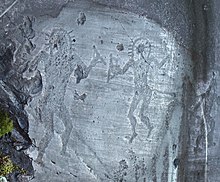 Petroglyphs from Val Camonica, Italy; ancient astronauts proponents believe that these figures resemble astronauts. | |
| Claims | Intelligent extraterrestrial life visited the Earth in ancient times and affected human civilization. |
|---|---|
| Related scientific disciplines | Archaeology |
| (Overview of pseudoscientific concepts) | |
| Part of a series on the |
| Paranormal |
|---|
Ancient astronauts (or ancient aliens) refers to a pseudoscientific set of beliefs[1][2][3][4] that hold that intelligent extraterrestrial beings (alien astronauts) visited Earth and made contact with humans in antiquity and prehistoric times.[1][2][4] Proponents of the theory suggest that this contact influenced the development of modern cultures, technologies, religions, and human biology.[1][2] A common position is that deities from most (if not all) religions are extraterrestrial in origin, and that advanced technologies brought to Earth by ancient astronauts were interpreted as evidence of divine status[a] by early humans.[1][2][5]
The idea that ancient astronauts existed and visited Earth is not taken seriously by academics and archaeologists, who identify such claims as pseudoarchaeological[6] or unscientific.[7] It has received no credible attention in peer-reviewed studies.[8] When proponents of the idea present evidence in favor of their beliefs, it is often distorted or fabricated.[9] Further, the history of thought surrounding the subject shows that proponents have adopted white supremacist beliefs to argue that indigenous cultures around the world were incapable of the feats of technology and culture that they achieved.[1][10][11]
Well-known proponents of these beliefs in the latter half of the 20th century who have written numerous books or appear regularly in mass media include Robert Charroux, Jacques Bergier, Jean Sendy, Erich von Däniken,[1][2][4] Alexander Kazantsev, Zecharia Sitchin, Robert K. G. Temple, Giorgio A. Tsoukalos, David Hatcher Childress, Peter Kolosimo, and Mauro Biglino.
- ^ a b c d e f Lieb, Michael (1998), "The Psycho-pathology of the Bizarre", Children of Ezekiel: Aliens, UFOs, the Crisis of Race, and the Advent of End Time, Durham, North Carolina and London: Duke University Press, pp. 51–54, 249–251, doi:10.2307/j.ctv11sn0vx.6, ISBN 978-0-8223-2137-8, OCLC 9354231
- ^ a b c d e Hammer, Olav; Swartz, Karen (2021), "Ancient Aliens", in Zeller, Ben (ed.), Handbook of UFO Religions, Brill Handbooks on Contemporary Religion, vol. 20, Leiden and Boston: Brill Publishers, pp. 151–177, doi:10.1163/9789004435537_008, ISBN 978-90-04-43437-0, ISSN 1874-6691, S2CID 243018663
- ^ May, Andrew (2016), Pseudoscience and Science Fiction (illustrated ed.), Heidelberg: Springer Verlag, p. 133, Bibcode:2017psf..book.....M, ISBN 978-3-319-42605-1
- ^ a b c Vetterling-Braggin, Mary (1983), "The Ancient Astronaut Hypothesis: Science or Pseudoscience?", in Grim, Patrick (ed.), Philosophy of Science and the Occult (1st ed.), Albany, New York: State University of New York Press, pp. 278–288, ISBN 978-0-87395-572-0, archived from the original on March 19, 2024, retrieved July 26, 2021
- ^ Cithara, vol. 1, Literary Licensing, LLC, November 1961, p. 12, ISBN 1258674610, archived from the original on February 20, 2022, retrieved June 8, 2019
- ^ Rathje, William (January–February 1978), "The Ancient Astronaut Myth", Archaeology, 31 (1), New York: Archaeological Institute of America: 4–7, ISSN 0003-8113, JSTOR 41726852
- ^ Cole, John R. (1980), "Cult Archaeology and Unscientific Method and Theory", in Schiffer, Michael B. (ed.), Advances in Archaeological Method and Theory, vol. 3, Cambridge, Massachusetts: Academic Press, pp. 1–33, doi:10.1016/B978-0-12-003103-0.50006-X, ISBN 978-0-12-003103-0, JSTOR 20170153, S2CID 142959012
- ^ Harrold; "Noah's Ark and Ancient Astronauts: Pseudoscientific Beliefs About the Past Among a Sample of College Students;" The Skeptical Inquirer; vol 11.1; 1986: 61; Committee for the Scientific Investigation of Claims of the Paranormal; December 13, 2010.
- ^ Cite error: The named reference
Hineswas invoked but never defined (see the help page). - ^ Cite error: The named reference
:2was invoked but never defined (see the help page). - ^ Cite error: The named reference
:3was invoked but never defined (see the help page).
Cite error: There are <ref group=lower-alpha> tags or {{efn}} templates on this page, but the references will not show without a {{reflist|group=lower-alpha}} template or {{notelist}} template (see the help page).